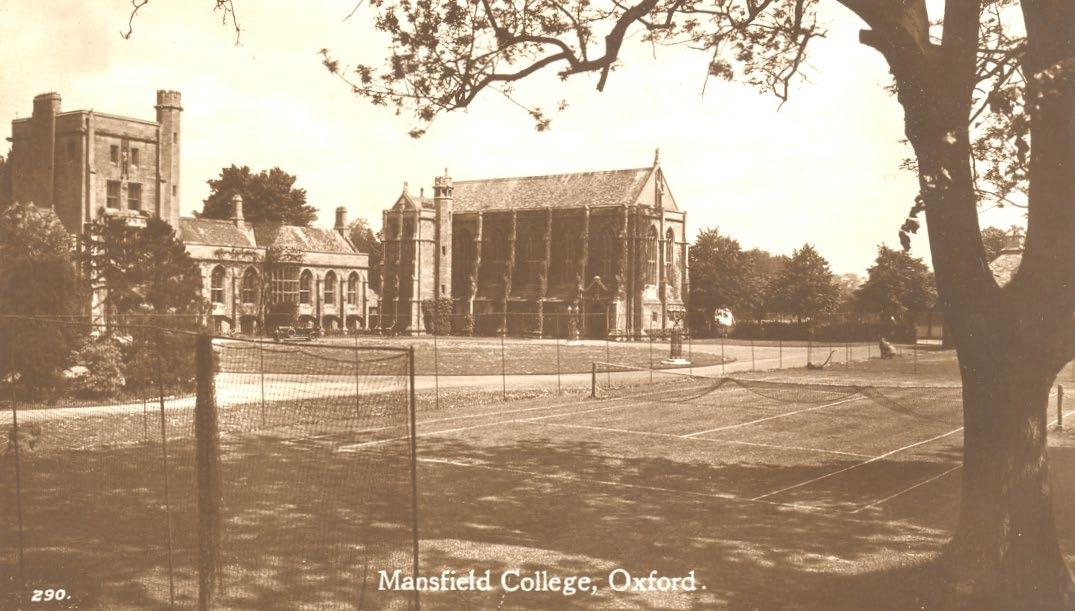
3 minute read
The way we were
In the first of a series of memoirs on Mansfield past, Mike Walton (English, 1956) reminisces about his initial weeks at the College as one of its two first non-Theology students. He is now the Honorary Secretary of the Mansfield College Alumni Association (MCAA).
I remember clearly my first visit to the College. While in Oxford for interview by another college, I decided to find out what Mansfield was like. I’d been offered an interview there but hadn’t found any helpful information (no internet back then!). From Broad Street, I followed about 50 yards behind a distinguished figure in full academic dress, walking at the same speed as my 17-year-old self. To my surprise, he turned into Mansfield Road, and then into the College, disappearing through the heavy front doors. I followed suit soon afterwards (no Porter’s Lodge then!). He was in the entrance hall and asked why I was interested in Mansfield. I told him. He asked my name. I told him. He replied, ‘Well, I’m John Marsh!’ – the Principal, who had been signing the letters I had received. I joined Mansfield the next October.
Advertisement
As I mentioned, there was then no Porter’s Lodge. And no student accommodation where the A, B, C and D Blocks now stand. No rooms along Mansfield Road, either. Where the Lodge, the student accommodation and the Fellows’ Garden are today there were once tennis courts. The Garden Building was similarly erected on the sacred turf of the cricket nets. Today, the croquet lawn remains, but someone has put a large sculpture in the middle of it. We students were mostly accommodated in the main building (my room was in the Tower, along with six or seven others including the JCR President, who gloried in the designated room on the first floor with the bay window). Space was at a premium, so there were two rooms built into the now-empty square area on the corner at the foot of the staircase. The top floor of the Principal’s Lodgings was divided into several student rooms (‘The Attic Community’), as was the basement. I spent my first year in College but had to find digs for my second and third years.
The lack of accommodation is related, of course, to the number of students: there were then approximately 50 (look at the College photos for those years). All of them were older than me. All Theology students were already graduates – only my fellow arts degree pioneer was of a similar age. Some of them had done National Service as well (in areas of conflict like Cyprus and Aden), so the maturity gulf was significant. This – not the Theology, but the National Service – was an issue across the whole University. Many students had even taken commissions, and as officers had served not two but three years. They had lived in a very different environment from that of my own suburban grammar school. We 18 year-olds had a lot to learn, and quickly. I felt very naive and raw. And I have always reckoned that, had I been at a larger, more ‘mainstream’ college, I might not have survived. Mansfield students were pretty decent people, and I felt protected within a somewhat private environment that allowed me to find my feet at my own rate. The College may be larger now, but I get the feeling that this characteristic has not changed.
Not everything happened at this steady rate. I arrived in College on a Wednesday. On Thursday, a notice went up inviting students to a hockey practice. I discovered Mansfield did not have a football or rugby team. So I borrowed a stick and turned up on Friday. On Saturday, the team was put on the noticeboard. I was astonished to discover my name appearing as a reserve. On Sunday, someone dropped out. On Monday, I was playing in the Mansfield College team. And I continued to do so for the whole of my three years. After Oxford, I played club hockey for many years, and coached successive sixth form groups whom I introduced to the game.
So thank you, Mansfield. This is just one of the many legacies I gratefully retain from my three years in your community.









